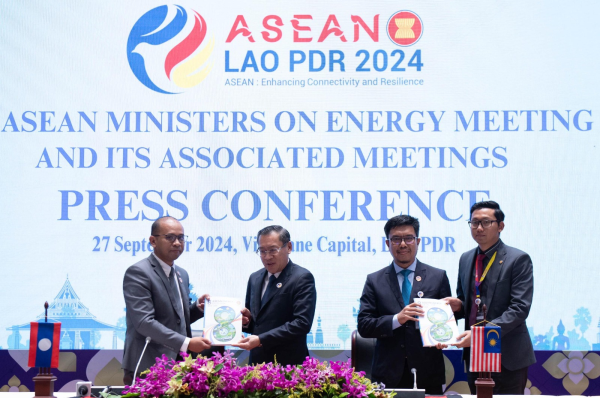KPL
The ASEAN Centre for Energy (ACE) is delighted to announce the launch of the 8th edition of The ASEAN Energy Outlook (AEO8) during the 42nd ASEAN Ministers on Energy Meeting (AMEM) and Associated Meetings, held on Sep 30 in conjunction with the 24th ASEAN Energy Business Forum (AEBF-24) in Vientiane, Lao PDR.

Photo 1. (left-right), Beni Suryadi, Acting Executive Director of ACE, and H.E. Phosay Sayasone, Minister of Energy and Mines (MEM), Lao PDR, with AEO8 at the 42nd AMEM opening ceremony
(KPL) The ASEAN Centre for Energy (ACE) is delighted to announce the launch of the 8th edition of The ASEAN Energy Outlook (AEO8) during the 42nd ASEAN Ministers on Energy Meeting (AMEM) and Associated Meetings, held on Sep 30 in conjunction with the 24th ASEAN Energy Business Forum (AEBF-24) in Vientiane, Lao PDR.
AEO8 is a flagship report, developed by ACE in close collaboration with the ASEAN Member States and partners, that supports the implementation of the ASEAN Plan of Action for Energy Cooperation (APAEC).
The report provides a comprehensive analysis of each programme areas in the energy landscape across ASEAN, outlining pathways to achieve national and regional energy targets and beyond up to 2050.
Phosay Sayasone, Minister of Energy and Mines, underscored the importance of AEO8 during his opening remarks on the Joint Opening Ceremony of 42nd AMEM with AEBF-24, stating “As the ASEAN Chairman this year, the Lao PDR recognises the importance of AEO8 as a fundamental guide in our journey towards achieving resilience and sustainable energy future. This report not only aligns with our national objectives, but also reinforces ASEAN's shared vision for a sustainable development."
The development of AEO8 was made possible by the ASEAN Member States (AMS) Working Group’s crucial data provision, along with the Regional Energy Policy and Planning Sub-Sector Network (REPP-SSN) active consultation.
Building on the 7th ASEAN Energy Outlook (AEO7), launched in Phnom Penh, Cambodia, in 2022, AEO8 offers a more comprehensive analysis and projections for each energy sector in ASEAN, ranging from electricity to energy efficiency, covering the period from 2022 to 2050 and aligning with ASEAN’s efforts to carbon neutrality.
Beni Suryadi, Acting Executive Director of ACE, underscores the significance of AEO8, stating “The ASEAN Centre for Energy (ACE) stands as a testament to advancing energy security, accessibility, affordability, and sustainability across the ASEAN region. The launch of AEO8 aims to provide a comprehensive analysis of ASEAN’s energy landscape and serves as a key document for the ASEAN Member States to support the ASEAN Plan of Action for Energy Cooperation (APAEC) implementation, achieving both national and regional energy targets by 2050. According to AEO8, energy demand in 2050 is 2.6 times higher than 2022. This rapid growth underscores the urgency for a coordinated efforts among ASEAN Member States to transition towards cleaner energy sources while maintaining economic growth and addressing the region’s rising energy needs.”
Acknowledging the diverse energy demands and situations across each country, AEO8 presents four distinct scenarios for a more comprehensive analysis of ASEAN's energy landscape.
The Baseline Scenario (BAS) explores pathway of no additional efforts on the energy efficiency and renewable energy policy as a reference point.
The AMS Target Scenario (ATS) highlights the impact of current national targets and policies, showing potential outcomes if current strategies are sustained. The Regional Aspiration Scenario (RAS) is the least-cost optimisation in power sector, while keeping 2025 APAEC targets and other regional standards, whenever possible, and using the additional constraints beyond 2025. Lastly, the Carbon Neutrality Scenario (CNS) emphasises decarbonisation effort using optimisation of low-emission technologies while keeping the 2025 APAEC targets.
In summary, AEO8 reveals:
• ASEAN end-use consumption is still dominated by industry and transport sectors, with coal and oil products dominating respectively. Overall, the final energy demand is expected to grow 2.6 times from 2022 to 2050.
• Reflecting the current APAEC targets, under the ATS, the region will have 39.6% of RE share in installed power capacity (overachieve) and 31% (close) of EI reduction by 2025. By 2030, it’ll have 23.5% of RE in TPES. Meanwhile, the RE in installed capacity could reach 44.1% and the EI reduction could reach 40.2%.
• Emerging technologies start to enter to ASEAN energy mix. For example, in the CNS, nuclear and tidal & wave in installed capacity are projected to exist starting from 2032 and 2035, respectively. New fuels in demand sector include Hydrogen and Sustainable Aviation Fuel (SAF), which will be introduced in the region's TFEC by 2023 and 2025, respectively.
The AEO8 serves as a critical resource designed to empower AMS in its pursuit of energy security, accessibility, affordability, and sustainability in the region. By providing detailed analyses and projections, AEO8 guides AMS navigate the complexities of the global energy transition while addressing the regional challenges ahead.
KPL